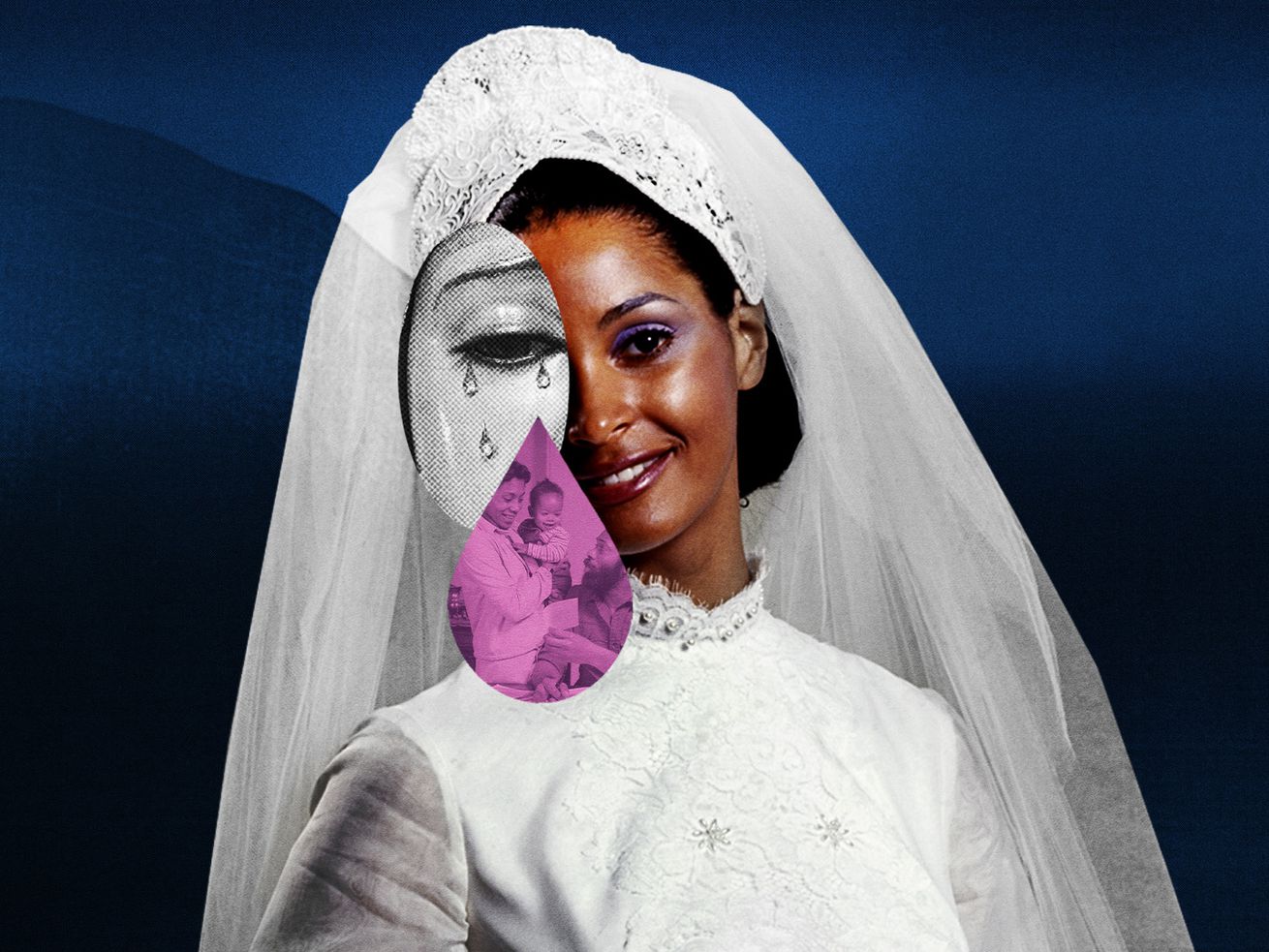
Brittany Holloway-Brown for Vox
How America has made it harder for Black people to marry.
Romantic relationships are in a weird place right now.
Sure, I have anecdotal evidence; I could open my phone and see a dating app horror story in any one of my group chats.
But I don’t have to take you through the dating woes of DC 30-somethings because data supports this too. Statistically, things are shifting. According to Pew Research, back in 1980 about 6 percent of Americans aged 40 and over had never been married. Now that number sits around 25 percent. If you’ve looked at the op-ed pages of any major newspaper, you’ve probably seen the hand-wringing about this falling marriage rate.
If you are or know a single person, this probably doesn’t come as too much of a surprise. But as I was looking at the numbers, one thing did surprise me: just how much lower the rate is for Black people. It’s always been lower, but the gap is now huge.
Back in the ’70s, a little over 20 percent of Black women had never been married. Now it’s nearly 48 percent.
Why do Black people get married less, and why does it matter?
Forbidden love
To answer that question for today’s episode of The Weeds — the latest in our “Black Women And …” series that looks at how policies are impacting Black women in particular — I spoke with Dianne Stewart, the author of Black Women, Black Love: America’s War on African American Marriage.
She argues that policy has made partnering especially difficult for Black people. Her answer centers around this idea that, for a long time, Black love in this country was forbidden — and that it still is.
It’s a statement that may feel provocative on its face, but Stewart argues that marriage is a civil right Black people were initially denied in America, and policy hasn’t done enough to catch up.
Though enslaved people often had informal marriages (there’s a reason it’s called jumping the broom), their unions weren’t legally recognized. Slave owners often separated families through sales, and would choose partners for enslaved people at will. This changed in 1865 with the end of slavery and the passage of the 13th Amendment, but after Emancipation, many families struggled to reunite. As late as the early 20th century, formerly enslaved people were putting out notices to find family members they had been separated from.
Barriers to partnership continued into the early 20th century. Until 1968, welfare operated with “man in the house” policies: If a woman was partnered with — or even dating — an able-bodied man, a family could no longer receive benefits. The thought process was that if a man was living in the house, then he should be able to fully provide for his family.
This disincentivized cohabitation and marriage for lower-income couples — a reality that disproportionately impacted Black families because many didn’t have wealth to begin with. The practice ended in 1968 with King v. Smith, when the Supreme Court ruled that the practice was unconstitutional.
How this plays out today
While many of these archaic policies no longer exist, their impacts are still felt today, and new policies have contributed as well.
The racism entrenched by slavery, for instance, plays a role. Take colorism, the phenomenon of discriminating against darker-skinned people that has its roots in colonialism and slavery. Historically, lighter-skinned people have been privileged because they’re closer to whiteness. That continues today, within larger institutions, and also within Black communities. In 2009, a study found that for women under 30, lighter-skinned Black women were married at twice the rate of their darker-skinned counterparts and 17 percent more than Black women with medium complexions.
For those seeking out relationships with Black men, there are also just fewer of those men in the dating pool. In 2021, Black men were incarcerated at over five times the rate of their white counterparts. Across race, women are earning college degrees at a higher rate than men, making it difficult for women who partner with men to find partners with the same educational background and economic status. Black women make up 66 percent of all African American bachelor’s degree holders, and those with degrees are more likely to marry someone with less education. College doesn’t equate to more wealth. The median net worth for college-educated Black households is $8,200; it’s $138,000 for white households with the same education.
This problem is exacerbated for Black people when you take into account what Stewart calls “wealth spread”: Black people who accumulate wealth are more likely to spend that money helping family members with less income. I call it the Teri Joseph effect. This makes a difference now that many consider marriage a capstone of adulthood rather than a cornerstone of it; Marriage is no longer that act that launches you into adulthood, but something you do when you feel emotionally and financially ready.
The statistics might not seem great if marriage is something you desire. But if you’re looking for love, all is not lost! Sure, the marriage rate is down, but that also means it was up at one point: Numbers are ever-evolving.
There are policies and solutions that could help change all this. For more on that — and a defense of the institution of marriage — check out my full conversation with Stewart.
This story appeared originally in Today, Explained, Vox’s flagship daily newsletter. Sign up here for future editions.
——————————————-
By: Jonquilyn Hill
Title: Why the marriage rate is falling faster for some
Sourced From: www.vox.com/24072078/marriage-america-race-policy-history
Published Date: Wed, 14 Feb 2024 12:15:00 +0000
Read More
Did you miss our previous article…
https://politicscope.com/social-issues/republicans-baseless-mayorkas-impeachment-sets-a-disturbing-precedent/
I'm a writer for lifestyle publications, and when I'm not crafting stories, you'll find me cherishing moments with my family, including my lovely daughter. My heart also belongs to my pets—Sushi, Snowy, Belle, and Pepper. Besides writing, I enjoy watching movies and exploring new places through travel.

